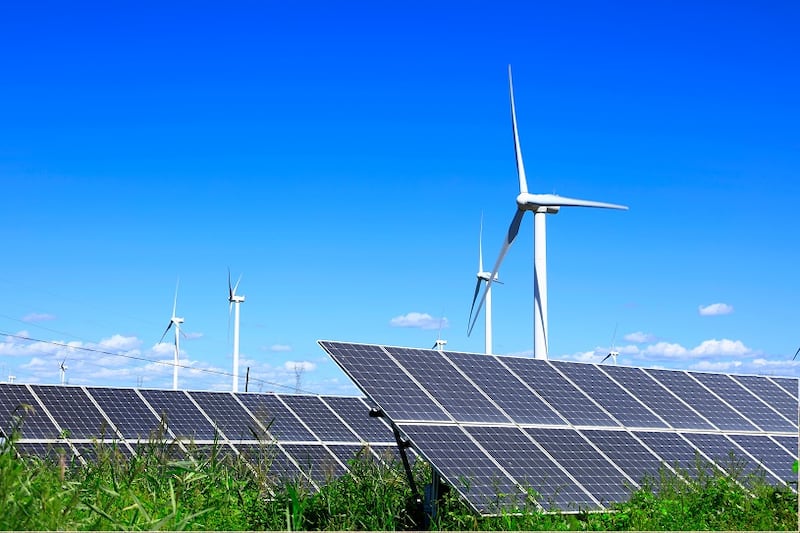Global additions of renewable power capacity are expected to increase by a third this year as growing policy momentum, higher fossil fuel prices and energy security concerns drive adoption of solar and wind power, according to a new report from the International Energy Agency.
The growth will continue next year, with the world’s total renewable electricity capacity rising to 4,500 gigawatts, equivalent to the total power output of China and the US combined, the Paris-based agency said in its Renewable Energy Market Update report, which was released on Thursday.
Global renewable capacity additions are expected to increase by 107 gigawatts, the largest absolute increase yet, to more than 440 gigawatts in 2023, the report added.
“Solar and wind are leading the rapid expansion of the new global energy economy. This year, the world is set to add a record-breaking amount of renewables to electricity systems – more than the total power capacity of Germany and Spain combined,” said Fatih Birol, IEA’s executive director.
“The global energy crisis has shown renewables are critical for making energy supplies not just cleaner but also more secure and affordable – and governments are responding with efforts to deploy them faster.
“But achieving stronger growth means addressing some key challenges. Policies need to adapt to changing market conditions, and we need to upgrade and expand power grids to ensure we can take full advantage of solar and wind’s huge potential.”
Investment in clean energy is expected to reach $1.7 trillion this year, outpacing spending on fossil fuels, as countries address potential energy shortages, a separate IEA report said last month.
Global energy investments in 2023 are projected to reach $2.8 trillion, with more than 60 per cent allocated for clean technologies, including renewables, electric vehicles, nuclear power and heat pumps, the Paris-based agency said in its World Energy Investment report.
The remaining 40 per cent will be spent on coal, natural gas and crude oil, the report said.
A record 295 gigawatts of renewable energy capacity was added around the world in 2022, up nearly 10 per cent from the year before, the International Renewable Energy Agency said in its Renewable Capacity Statistics 2023 report released in March.
Renewables are at the forefront of Europe’s response to the energy crisis, accelerating their growth there, the IEA report said.
New policy measures are also helping drive significant renewable energy capacity increases in the US and India over the next two years.
Business Extra in Davos: Energy in crisis and transition

China is consolidating its leading position and is likely to account for almost 55 per cent of global additions of renewable power capacity in 2023 and 2024, according to the IEA.
Solar photovoltaic cell additions will account for two thirds of this year’s increase in renewable power capacity and are expected to keep growing in 2024, the report found.
“Higher electricity prices are stimulating faster growth of rooftop solar PV, which is empowering consumers to slash their energy bills,” the IEA said.
“Manufacturing capacity for all solar PV production segments is expected to more than double to 1,000 GW by 2024, led by China and increasing supply diversification in the US, India and Europe.”
The world will have enough solar PV manufacturing capacity in 2030 to comfortably meet the level of annual demand envisaged in the IEA’s net-zero-emissions-by-2050 scenario, according to the IEA.
Meanwhile, wind power additions are also forecast to rebound sharply this year, growing by about 70 per cent year on year “after a difficult couple of years in which growth was sluggish”.
“The faster growth is mainly due to the completion of projects that had been delayed by Covid-19 restrictions in China and by supply chain issues in Europe and the US,” the report said.
“However, further growth in 2024 will depend on whether governments can provide greater policy support to address challenges in terms of permitting and auction design.
“In contrast to solar PV, wind turbine supply chains are not growing fast enough to match accelerating demand over the medium term. This is mainly due to rising commodity prices and supply chain challenges, which are reducing the profitability of manufacturers.”
The IEA has revised upwards the forecast for renewable capacity additions in Europe by 40 per cent from before Russia’s invasion of Ukraine, which led many countries to boost solar and wind uptake to reduce their reliance on Russian natural gas.
Newly installed solar and wind capacity is estimated to have saved EU electricity consumers €100 billion ($106.8 billion) during the period 2021 to 2023 by displacing more expensive fossil fuel generation, according to the report.
Wholesale electricity prices in Europe would have been 8 per cent higher in 2022 without the additional renewable capacity, according to the IEA’s findings.
Government policies need to adapt to changing market conditions, particularly for renewable energy auctions, which were undersubscribed by a record 16 per cent last year, the IEA said.
Policies also need to focus on timely planning and investment in grids to integrate high shares of renewables in power systems, the agency suggested.







